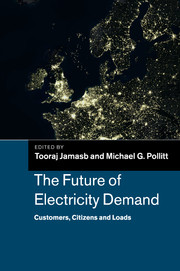Book contents
- Frontmatter
- Contents
- List of Figures
- List of Tables
- List of Boxes
- List of Contributors
- Foreword
- Preface
- Acknowledgements
- Introduction and overview of the chapters
- Part I The economics
- Part II Technology
- 5 Demand-side management and control in buildings
- 6 Smart metering: technology, economics and international experience
- 7 Smart domestic appliances as enabling technology for demand-side integration: modelling, value and drivers
- 8 The scope for and potential impacts of the adoption of electric vehicles in UK surface transport
- Part III Social dimensions
- Part IV Policy and regulation
- Index
- References
6 - Smart metering: technology, economics and international experience
from Part II - Technology
Published online by Cambridge University Press: 05 March 2014
- Frontmatter
- Contents
- List of Figures
- List of Tables
- List of Boxes
- List of Contributors
- Foreword
- Preface
- Acknowledgements
- Introduction and overview of the chapters
- Part I The economics
- Part II Technology
- 5 Demand-side management and control in buildings
- 6 Smart metering: technology, economics and international experience
- 7 Smart domestic appliances as enabling technology for demand-side integration: modelling, value and drivers
- 8 The scope for and potential impacts of the adoption of electric vehicles in UK surface transport
- Part III Social dimensions
- Part IV Policy and regulation
- Index
- References
Summary
Introduction
As we have seen particularly from Part I of this volume, the participation of the demand side is essential in improving the overall efficiency of energy markets. In liberalized electricity markets, active demand-side participation has been limited to date, although there is increasing emphasis on its importance in contributing to a number of energy policy challenges (Bilton et al., 2008; Borenstein et al., 2002; Spees and Lave, 2007). Climate change, security of supply and fuel poverty are the three main areas where a more active demand side has the potential to have both significant and cost-effective impacts (Ofgem, 2006b). The widespread recent interest in smart electricity and gas metering can best be understood in this context. Innovative forms of metering allow for more detailed information to be collected on consumption. Communications technology facilitates greater interaction between the end-user and the rest of the supply chain. Both information and interaction allow for end-users to become more actively involved by, for example, responding to price signals.
Smaller users (domestic, small and medium-sized enterprises (SMEs)) have been the focus of recent smart metering policy debate around the world as they have traditionally not been given the appropriate incentives, means or information to become active participants in energy markets. In the European Union (EU), the 2006 Energy Services Directive (2006/32/EC) has given impetus to the debate by requiring member states to incorporate metering and billing policies into their National Energy Efficiency Action Plans. This has prompted a number of EU countries to explore the costs and benefits of implementing smart metering as well as the appropriate models and regulatory frameworks for deployment. The recent interest in smart grids in both the EU and the US provides a broader framework for looking at some of these issues. Although the definition of a smart grid is a work in progress, the overall aim of developing smart grids is to modernize the electricity system in such a way that it will be able to deal with increased complexity in an efficient and reliable manner. Part of this complexity comes from a more active demand side. Other important factors include the integration of greater amounts of renewable generation, distributed generation and the use of more advanced network control technologies to reduce losses (ERGEG, 2009).
- Type
- Chapter
- Information
- The Future of Electricity DemandCustomers, Citizens and Loads, pp. 161 - 184Publisher: Cambridge University PressPrint publication year: 2011
References
- 7
- Cited by



